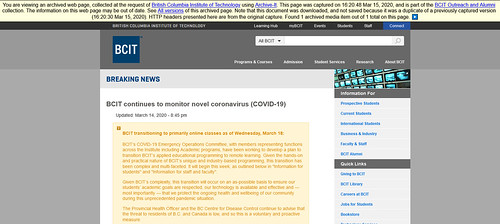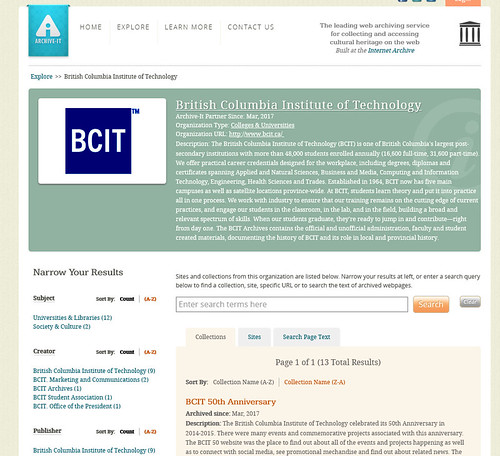All of 2021 I have found myself looking back to what I was doing and what was going on in 2020. There are many Anniversaries of note: when those of us who could, started working from home, and became armchair epidemiologists, when borders closed, trips were cancelled, when I last had an in real life meeting with colleagues, and when Prime Minister Justin Trudeau asked people to refrain from “speaking moistly.” COVID-19 impacted all of our lives to varying degrees. Most of us know someone who was sickened by the coronavirus. Some of us lost a loved-one. Many BCIT grads, students, faculty, and staff stepped up to help out in any way that they could.
The above is BCIT’s Breaking News website captured March 15, 2020. To watch Kathy Kinloch deliver her message to the BCIT Community about the rapidly developing situation you can visit the page I captured with Archive-It, and click the blue play button located at the top right of the banner. Also in the banner, you can see that this page was crawled on March 15, 2020. If you click on ‘All versions’ in the banner you can see other capture dates.
Looking back at the Spanish Flu pandemic of 1918-1920 the best sources for research are found in archives. These primary sources are used as evidence in books, legal disputes, thesis, blogs posts, and other historic publications. Being an Archivist I was quickly made aware of blog posts that highlighted parallels of this time. A couple of favourites were The Spanish influenza: the deadly pandemic of 1918 from Queen’s University Alumni Review & UBC and the last great pandemic 1918-1919. Primary or original sources used for these articles include photographs, diaries, scrapbooks, reports, and newspaper articles.
This is what the School of Health main page looked like in May of 2020. Note the “Important Notice: COVID-19 Institute response” at the top of the page. This snapshot was taken prior to the switch to WordPress when BCIT’s website took on a whole new look and feel.
Where are the records tracing BCIT’s experience of the current pandemic? Some of them are on the social media sites of our students and community.** Others are in various offices around BCIT where decisions, big and small, are made. Many of these decisions are shared and updated on BCIT’s website. In March of 2020 I started using the BCIT Archives Archive-It account to collect the BCIT Breaking News website where regular Institute updates could be found. Once it became clear that our new reality would include COVID-19 for an extended time a special COVID-19 website was created where updates for students and staff could be regularly shared. Snapshots of what the BCIT COVID-19 response was are now full-text searchable on the BCIT Archive-It page. Researchers of the future will note the COVID-19 banner prominently splashed across the top of much of BCIT’s websites for the duration of the pandemic.
BCIT Archive-It homepage where you can full-text search collected webpages. Including the BCIT 50th Anniversary websites and other obsolete BCIT webpages.
The Internet Archive Wayback Machine is a popular resource for finding obsolete or removed websites (the average website lifespan is less than three years) or verifying what inflammatory or incriminating statements politicians or celebrities have removed from their websites. In order to search the Wayback Machine you need to know the exact URL of the page you want to visit. This is not the case for the Archive-It service where full text searching of captured pages is a key feature. The BCIT Archives has been using Archive-It to collect websites of historical importance to BCIT since 2017. The advantages of using Archive-It are many; I have been able to create curated collections, add metadata, run tests, put in tickets for help, connect with the Archive-It community, and set up automatic crawls. Of immediate concern in the spring of 2017 were the 50th Anniversary websites and Update blog, which first moved to the web in 2004. You can find thirteen years of the Update blog on Archive-It. The paper versions are available as full text searchable PDFs in the BCIT Archives database.
If you are familiar with the Internet Archive’s Wayback Machine you will recognize the capture information at the top of the screen. “You are viewing an archived web page…This page was captured on 20:48 Mar 11, 2017…” etc. Here is a screenshot of BCIT’s 50th Anniversary merchandise page.
For scholars studying the 1990s onward web archives are an invaluable resource. A great project out of the University of Waterloo and York University called Archives Unleased Cloud has created open-source analytical tools and a collaborative community of scholars. A couple of years ago I was fortunate to be able to participate in a workshop where archivists and researchers got to try some of the tools they had created for analyzing website collections. Since then, Archives Unleashed has become more powerful and, from the test versions I have had access to, more user friendly. The project is moving to the Archive-It platform – a perfect partnership that supports the longevity of the project and allows for seamless collecting and analyzing of web archives.
SE16 BCIT Recreational Services gym set up for in real life exams February 2021. BCIT Archives item no. C19-s01-010.
The global pandemic continues to rage on and create many uncertainties in our lives. As COVID-19 dominates the headlines web-archivists in Canada and around the world are ensuring that the researchers of the future will have access to the records of these “interesting” times. The BCIT Archives has created a, so far, all-digital BCIT COVID-19 collection. This collection includes links to relevant Archive-It web archives collections and digital photographs of the BCIT-community’s experience of the past nineteen months.
**Preserving social media sites is prohibitively challenging for many reasons including privacy and the proprietary nature of the platforms themselves.
This blog post has been adapted from a blog post that I wrote for the BCIT intranet; first published March 16, 2021.





